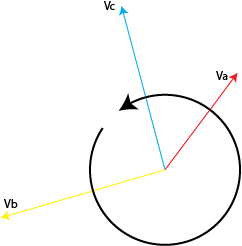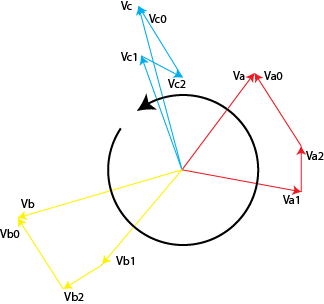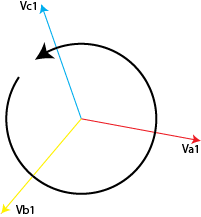Introduction
An important aspect of Power Quality Monitoring and Analyzes is to have an insight into the complex dynamics of power systems. This is to understand why the three-phase voltages or currents are not of the same magnitudes or phase-displaced by 120-degrees.
When a three-phase circuit becomes unbalanced, the voltages and currents are no longer equal. In the picture below the three-phases as measured are displayed.

The very first step is this to decompose the unbalanced three-phase quantities into their symmetrical components. This will produce the resulting “symmetrical” components which are referred to as direct (or positive), inverse (or negative) and zero (or homopolar). Therefore, it simplifies the analysis of unbalanced three-phase power systems under both normal and abnormal conditions.
In a three-phase system, a positive-sequence set of voltages or currents produces a normal rotating field, a negative-sequence set produces a field with the opposite rotation, and the zero-sequence set produces a field that oscillates but does not rotate. This is very important to note. The zero-sequence component is the one that produces heat in transformer and cables. For a more detailed explanation, read the Negative Phase Sequencing explanations.
As shown in the figure below, the three sets of symmetrical components (positive-, negative-, and zero-sequence) add up to create the system of three unbalanced phases Va, Vb and Vc.

The imbalance between phases arises because of the difference in magnitude and phase-shift between the sets of vectors. Notice that the colors (red, blue, and yellow) of the separate sequence vectors correspond to three different phases (a, b, and c, for example).
Positive-Sequence Component
The positive-sequence component is one of the symmetrical components derived from an unbalanced three-phase system. It represents the balanced part of the system that resembles a three-phase system with equal magnitudes and 120° phase separations. See the figure below.

The positive sequence component is denoted by the subscript “1” and represented as Va₁, Vb1, and Vc1 for the three voltages respectively.
Negative-Sequence Component
The negative sequence component is another symmetrical component obtained from an unbalanced three-phase system. It represents the symmetrical imbalance caused by phasors that are equal in magnitude but have a phase sequence opposite to that of the original phasors. See the figure below.

The negative-sequence component is essential for identifying issues like unbalanced loads and diagnosing faults in the system, as it helps distinguish between symmetrical and unsymmetrical faults.
The subscript “2” denotes the negative sequence component and represents Va₂, Vb2 and Vc2 for the three voltages respectively.
Zero-Sequence Component
The zero-sequence component, the third symmetrical component, describes a unique condition where the three phasors have equal magnitudes and zero phase displacement from each other. This component primarily captures the presence of ground faults or imbalances that affect all three phases equally.

The subscript “0” denotes the zero-sequence component, represented as Va₀, Vb0 and Vc0 for the three voltages respectively.
Symmetrical Current Animation
It is important to note that different counties employ different wiring color standards. Over and above that, countries such as South Africa, have two sets of color code standards, one for flexible cable and another fixed cables.
On this web page both are being used since the color codes for fixed cables does not display that when it comes to the Symmetrical Current Animations below.
Electrical Wire Color Codes
Flexible Cable
The wire color codes from this category are extension cord, power cable, and lamp cords wiring color. South Africa uses this IEC 60446 (International Electrotechnical Commission) for flexible cable:
- Single phase, Line (L) = brown
- Three phase, Line 1 (L1) = brown
- Three phase, Line 2 (L2) = black
- Three phase, Line 3 (L3) = grey
- Neutral (N) = blue
- Protective earth (PE) = green-yellow
